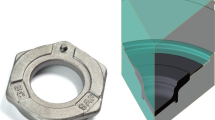Abstract
Precision forging is a field in which decision support systems can be effectively and widely applied and depends on knowledge and rules derived from the past experience of forging die design engineers. Precise components are becoming quite important in attempts to reduce cost and improve reliability. There are thus many application areas in which the rules themselves become inherent to the parts or the processes. In forging die design, dimensional accuracy is one of the main goals. The load carrying capacity and life of any forged product is greatly affected by its dimensional accuracy. To predict the precise dimension of the part and determine the die dimension for precision forging, it is necessary to analyze the factors which affect dimensional accuracy. Dimensional evolution of die and product should be analyzed at each stage of forging. In this study, both radial and tangential stresses are encountered in the determination of die stresses since cylindrical workpieces were used. In order to sustain dimensional accuracy of the forging die, differences between the forging product and the die insert such as elastic die expansion and product contraction are presented.
Similar content being viewed by others
References
Lee YS, Lee JH, Kwon YN, Ishikawa T (2004) Analysis of the elastic characteristics at die and workpiece to improve the dimensional accuracy for cold forged part. J Mater Process Tech 153–154:1081–1088
Peng X, Quin Y, Balendra R (2003) FE analysis of springback and secondary yielding effect during forward extrusion. J Mater Process Tech 135:211–218
Park YB, Lee KH (2001) Study on the deformation of die and product in closed die upsetting. J Mater Process Tech 118:417–421
Lee Y, Lee J, Ishikawa T (2002) Analysis of the elastic characteristics at forging die for the closed forged dimensional accuracy. J Mater Process Tech 130:532–539
Fujikawa S, Ishihara A (1997) Development of expert systems for forging processes. J Soc Automot Eng Japan 18:127–133
Park YB, Lee KH (2001) Study on the deformation die and product in closed die upsetting. J Mater Process Tech 118:417–421
Koç M, Arslan M (2003) Design and finite element analysis of innovative tooling elements (stress pins) to prolong die life and improve dimensional tolerances in precision forming processes. J Mater Process Tech 142:(3):773–785
Kojima Y et al (1985) Measurement of pressure distribution in drawing of bars. J JSPE 855–861
Matsubara S, Kudo H (1991) Devising and calibration of a simple sensor for determining pressure distribution on tool workpiece interfaces. J JSTP 589–596
Matsubara S, Kudo H (1991) Nonuniform pressure distribution on punch nose surface in axisymmetric cold forging processes. J JSTP 874–879
Takshashi S, Brebbia CA (1990) Forging die stress analysis using boundary element method. Advanced Tech Plast 203–210
Sadeghi MH, Dean TA (1991) Analysis of dimensional accuracy of precision forged axisymmetric components. J Eng Manuf 205(4):171–178
Eyercioglu O, Dean TA (1997) Design and manufacture of precision gear forging dies. CIRP international conference on design and production of dies and molds, Istanbul, Turkey
Yilmaz NF, Eyercioglu O (2003) Application of UBET in the prediction of forging load for axisymmetric forging. Int J Adv Manuf Syst 6:1–11
Kuzman K (2001) Problems of accuracy control in cold forming. J Mater Process Tech 113:10–15
Qin Y, Balendra R (1997) FE simulation of the influence of die elasticity on component dimensions in forward extrusion. J Mach Tools Manuf 37:183–192
Hou J (1997) A plane strain UBET analysis of material flow in a filled deep die cavity in closed die forging. J Mater Process Tech 70:103–110
Rantunga V, Gunesakara J, Frazier W, Hur K (2001) Use of UBET for design of flash gap in closed die forging. J Mater Process Tech 111:107–112
Gerhard H, Atlan T (1989) Investigation of die stresses and die deflections in forging axisymmetric parts. Steel Research N 60:255–262
Park YB (2001) Study on the deformation of die and product in closed die upsetting. J Mater Process Tech 118:417–421
Mazyad M (2004) Computer modeling of complex metal forming processes using the upper bound elemental technique (UBET) and modified upper bound elemental technique (MUBET). PhD Thesis, Ohio University, USA
Yilmaz NF (2002) An expert system for near net shape axisymmetric forging die design. PhD Thesis, University of Gaziantep, Turkey
American Society for Metals (1975) Source book on cold forming. ICFG data sheet no 70003. ASM, Metals Park, Ohio
American Society for Metals (1975) Source book on cold forming. ICFG data sheet no 6/72. ASM, Metals Park, Ohio
Sadeghi MH (1989) Precision forging axisymmetric shapes, straight and helical spur gears. PhD Thesis, University of Birmingham, UK
Male AT, DePierre V, Saul G (1972) The validity of mathematical solutions for determining friction from the ring compression test. J Lubr Technol 96:389–397
Mielnik EM (1991) Metalworking science and engineering. McGraw-Hill, New York
Author information
Authors and Affiliations
Corresponding author
Rights and permissions
About this article
Cite this article
Yilmaz, N.F., Eyercioglu, O. An integrated computer-aided decision support system for die stresses and dimensional accuracy of precision forging dies. Int J Adv Manuf Technol 40, 875–886 (2009). https://doi.org/10.1007/s00170-008-1402-z
Received:
Accepted:
Published:
Issue Date:
DOI: https://doi.org/10.1007/s00170-008-1402-z




